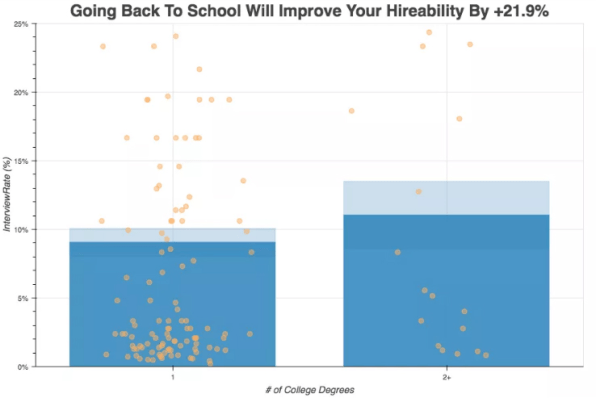#CareerAdvice : #ResumeWriting – How to Write a #Resume That Will Impress a Bot ( #AI )…Great REad!
Getting hired used to mean writing a resume that stood out to the HR manager or recruiter assigned to thumb through them. Today, the gatekeeper is a machine as AI revolutionizes the hiring process. That means the way you write your resume has changed, too.
“AI is handling processes that used to take an enormous amount of time away from engaging with the talent pool,” says Jon Christiansen, PhD, chief intelligence officer of the marketing research firm Sparks Research. “HR managers don’t have to sift through hundreds of resumes, and they can get into their real expertise of recruiting and placing the right talent.”
While this is good news for the HR department, it adds a new challenge for candidates, says Arran Stewart chief visionary officer and co-founder of Job.com, a recruiting platform.
“AI has made the resume writing process far more competitive as it now requires emphasis on personalizing the document for the job in question rather than submitting a generic resume for a myriad of vacancies,” he says. “Where recruiters and hiring managers are able to read between the lines and find the relevance of any skill or accomplishment on your resume to the open positions they have, AI is only concerned with how closely your resume matches with the skills it’s been asked to look for in the job you applied to.”
Get past the bot and in front of the HR manager by doing these six things:
1. WRITE A NEW RESUME FOR EVERY JOB
The ability to blast out one version of a resume and get nibbles is over. Now you have to write a resume that speaks to the job description.
“The job description contains several clues about what the machine is looking for,” says Christiansen. “It’s saying, ‘Here are the knowledge skills I’m looking for, and here’s background I’m looking for.’ Look at the tags, keywords, and streams of text; that’s where you should get started.”
Apply the language to the resume you submit to the job in question, says Stewart. “AI is looking for singular relevance to the role they’re searching for, so including job-specific language is a must if you want to make it to the shortlist,” he says. “It might be slightly more work, but no different than say having different cover letters ready for each position.”
Like this Article ? Share It ! You now can easily enjoy/follow/share Today our Award Winning Articles/Blogs with Now Over 2.5 Million Growing Participates Worldwide in our various Social Media formats below:
FSC LinkedIn Network: www.linkedin.com/in/fscnetwork
Facebook: http://www.facebook.com/pages/First-Sun-Consulting-LLC-Outplacement-Services/213542315355343?sk=wall
Google+: https://plus.google.com/115673713231115398101/posts?hl=en
Twitter: Follow us @ firstsunllc
Question: Want the ‘the best/current articles/blogs on the web’ on Job Search, Resume, Advancing/Changing your Career, or simply Managing People?
Answer: Simply go to our FSC Career Blog below & type(#career, #leadership, #life) in Blog Search: https://www.firstsun.com/fsc-career-blog/
What Skill Sets do You have to be ‘Sharpened’ ?
Continue of article:
2. USE EASY TO UNDERSTAND JOB TITLES
Some companies like to assign creative job titles, like Branding Guru or Planning Expert, but including them on your resume might get you passed over by the machine.
“It’s cool for culture, but that’s not the tags the machine is looking for,” says Christiansen. “If the job description says they’re looking for a marketing manager or product manger, that’s the tag it’s going to look for.”
Christiansen suggests going to the Bureau of Labor Statistics or O-NETand searching standard job titles. “If you can’t find your job title, it’s probably not going to be picked up and tagged during the machine screening,” he says.
Also consider the job progression, adds Stewart. “AI isn’t at the point of a mass scale predictive, so if you’re applying for a job that is senior to your current role as a logical next step in your career, AI won’t make the connection that it is the logical next step,” he says. “If your experience and skills make you seem underqualified, you should write in aspirational terms about your skills and accomplishments. That way the system views you as ready to take on the added challenge.”
3. RESIST THE URGE TO BE CREATIVE
Machines don’t judge you by the font you choose. If you have a font that can’t be read by most word processors, you might get spit out.
“Any font that isn’t within the Microsoft Word platform might not be able to be read,” says Christiansen. “Sometimes using a PDF format might work, but it’s not worth the risk.”
And don’t add graphics. Tables or images might look good, but again, the bot might not be able to recognize it.
“It might look like wasted space to a machine,” says Christiansen.
4. BE PRECISE
Including a long history of experience is no longer necessary, so try to keep your list of experience within the last five years, says Stewart.
“A full 20 years of work history dilutes the experience concentration weighing your resume, which will result in you being removed from shortlists,” he says. “When writing your resume remember the two Rs: keep it relevant and recent.”
5. CHECK YOUR SPELLING
You never want your resume to include spelling or grammatical errors, but a human might have been more forgiving than a machine.
“AI not only sorts through irrelevant applicants, in some cases it highlights the lazy ones as well,” says Stewart. “It’s still important to be sure your information is still meeting the usual standards of excellence expected for professional documents.”
6. INCLUDE A COVER LETTER
While a resume should be written to match the job and advance you past the bot, the cover letter is your chance to shine, says Christiansen.
“It’s an opportunity to speak like a human,” he says. “You can speak directly to the hiring manager, make yourself sound like a human and talk uniquely about the experiences you mentioned that spoke to the job description.”
Christiansen recommends writing three or four paragraphs about how you could fit that team, company and job. “Get into the why,” he says. “A cover letter may be an old practice, but I don’t see them go away. A good hiring manager wants to hear you in that.”
Taking these six steps involve more work on the part of the candidate, but skipping them might be a bigger risk.
“If you send out a generalized resume, it’s a case of garbage in/garbage out,” he says. “You want to get a match because you fit the job. If you’re getting calls from a generalized resume it’s because those companies want warm bodies, whether or not they fit the job. Is that where you want to work?”
FastCompany.com |April 1, 2019 | BY STEPHANIE VOZZA 4 MINUTE READ








